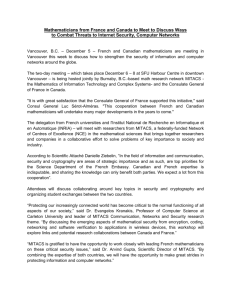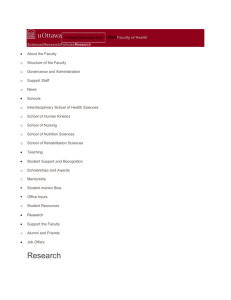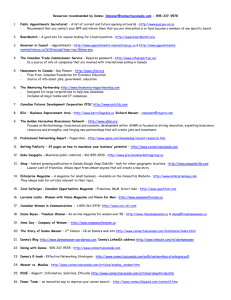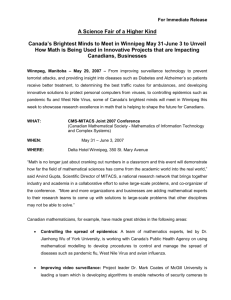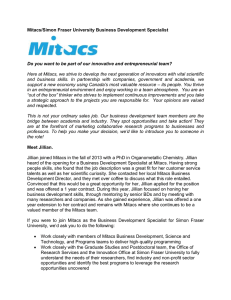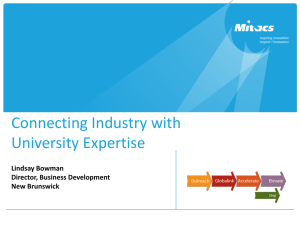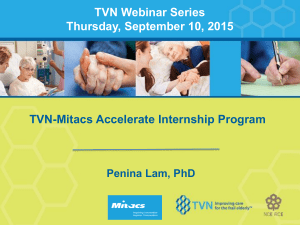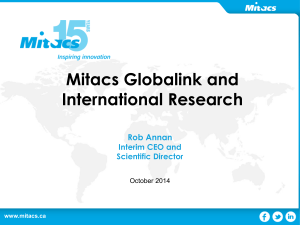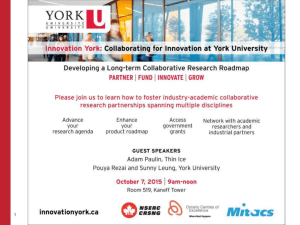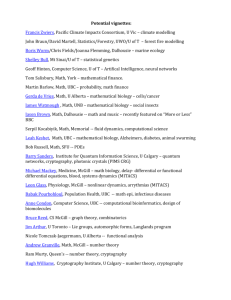For Immediate Release
advertisement
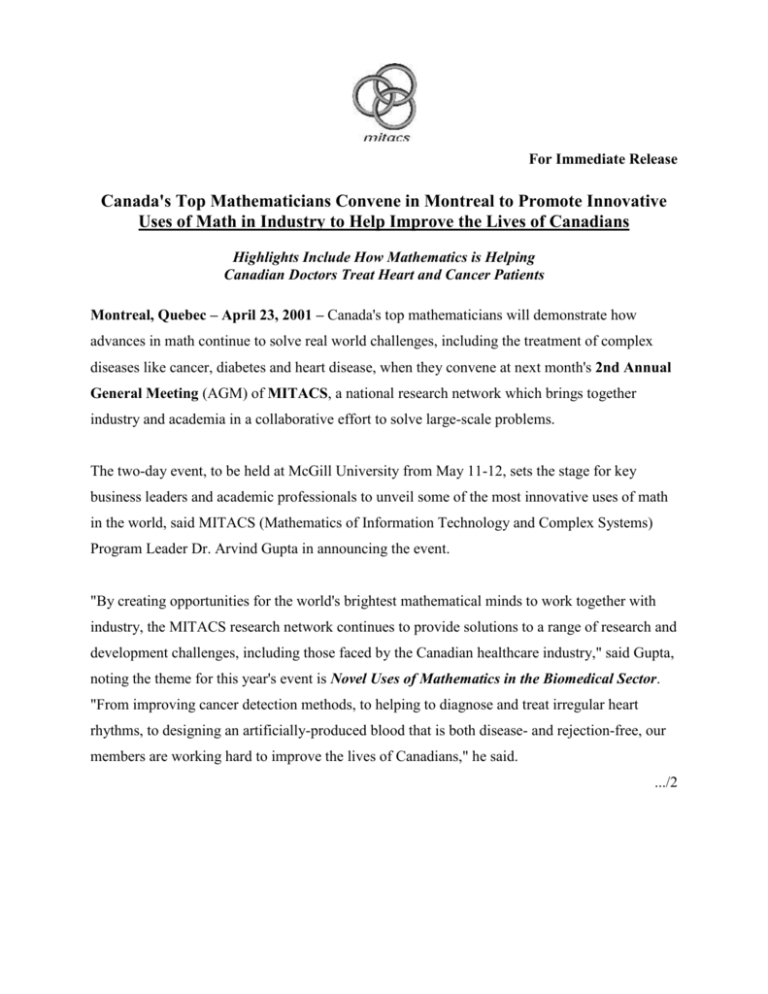
For Immediate Release Canada's Top Mathematicians Convene in Montreal to Promote Innovative Uses of Math in Industry to Help Improve the Lives of Canadians Highlights Include How Mathematics is Helping Canadian Doctors Treat Heart and Cancer Patients Montreal, Quebec – April 23, 2001 – Canada's top mathematicians will demonstrate how advances in math continue to solve real world challenges, including the treatment of complex diseases like cancer, diabetes and heart disease, when they convene at next month's 2nd Annual General Meeting (AGM) of MITACS, a national research network which brings together industry and academia in a collaborative effort to solve large-scale problems. The two-day event, to be held at McGill University from May 11-12, sets the stage for key business leaders and academic professionals to unveil some of the most innovative uses of math in the world, said MITACS (Mathematics of Information Technology and Complex Systems) Program Leader Dr. Arvind Gupta in announcing the event. "By creating opportunities for the world's brightest mathematical minds to work together with industry, the MITACS research network continues to provide solutions to a range of research and development challenges, including those faced by the Canadian healthcare industry," said Gupta, noting the theme for this year's event is Novel Uses of Mathematics in the Biomedical Sector. "From improving cancer detection methods, to helping to diagnose and treat irregular heart rhythms, to designing an artificially-produced blood that is both disease- and rejection-free, our members are working hard to improve the lives of Canadians," he said. .../2 -2- An interdisciplinary MITACS team of Canadian physicians, mathematicians, physiologists and industrial partners, for example, is currently developing a unique approach to controlling atrial fibrillation, an abnormal heart rhythm or arrhythmia, which affects approximately 80,000 Canadians each year and has serious complications associated with it, including a higher risk of stroke. Currently, the only way to determine whether a patient suffers from this condition is to examine the results from an electrocardiogram test. By recording and studying the intervals between heartbeats, MITACS researchers have come up with a set of mathematical computations they say could change that. “Almost nobody thinks math has something to do with your heart, including all of the doctors who expertly treat your heart,” notes Dr. Leon Glass, MITACS project leader and a professor at McGill University. “We have developed techniques that could be used in a simple device worn by a patient to help determine – with a reasonable degree of precision – that a person suffers from this arrhythmia, no matter when it occurs.” Once detected, the abnormal rhythm can then be treated accordingly, he adds, whether that means taking medication or coming into the hospital to undergo a medical procedure, ultimately reducing the risk of stroke. Another MITACS project, led by Senior Scientist Dr. Shelley Bull, has caught the interest of several groups within the Ontario Cancer Institute for its promise in helping to develop new diagnostic tools, more targeted treatments and early detection methods for complex diseases like cancer. The researchers have created a statistical tool that sorts out multiple factors contributing to a person’s likelihood of developing cancer, including genetics, environmental conditions and dietary habits. In addition to assisting with early detection, the data collected can also be used to determine which cancer therapies will work best for a particular group of patients, notes Bull. .../3 -3- These projects, and many others, will be exhibited at the upcoming MITACS AGM, which is expected to attract more than 400 students, business leaders, top scientists and members of the media. Conference highlights include: Seminars on Current Mathematical Topics: World-class speakers will address the role of mathematics in industry, including how it applies to the ongoing evolution of the Internet, pharmaceutics and the world of finance. Exhibition: A first-hand look at how MITACS researchers are solving problems within the biomedical, and other, sectors. Highlights include: a working model of human brain activity that is aiding in the study of Tinnitus, a medical condition that causes ringing in the ears and affects roughly 360,000 Canadians; the latest findings in stem cell research that may eventually lead to the design of an artificially-produced blood in an effort to ease Canada's blood supply crisis; and, innovative work in the area of diabetes and Alzheimer's Disease. MITACS creates jobs for students and post-doctoral fellows Based on the success of their work within the MITACS network, students and post-doctoral fellows are being offered more positions and career opportunities than ever before, according to Gupta. “In the two years since its inception, MITACS has established a new benchmark in academic excellence,” he said. “With the support of the federal government, Canadian research funding is pushing the envelope of technology and innovation while continuing to create permanent positions for scientists, researchers, graduate students and technicians, right here at home.” Organizations currently benefitting from MITACS' talent pool include Nortel Networks, TELUS, Proctor and Gamble Inc., Hydro-Quebec, National Bank of Canada and Canadian Airlines, as well as many government agencies and medical institutions across the country. .../4 -4- About MITACS MITACS is a federally-funded Network of Centres of Excellence in mathematical sciences. Operating as a national framework under which scientists and organizations in the private sector can collaborate to solve large-scale problems, it represents a joint initiative by Canada's three mathematical institutes - Le Centre de recherches mathematiques, The Fields Institute for Research in Mathematical Sciences and The Pacific Institute for the Mathematical Sciences. Launched in October 1999, MITACS has teamed more than 230 researchers with 70 companies to work in tandem on specific projects. MITACS focuses its research efforts within five key areas of the Canadian economy: biomedical, industrial/ commercial, information technology, trading/finance, and manufacturing. - 30 - Media are invited to attend the MITACS Exhibition on May 11-12 from 11:15 a.m. - 2:00 p.m., at McGill University, Students' Union Building, Shatner Ballroom, 3480 McTavish St. The MITACS AGM will be held in the Leacock Building, Field House Auditorium, 855 Sherbrooke St. West on May 11-12 from 7:30 am to 5:00pm. A separate Media-VIP room will be set up in the Arts Building, Room 160, 853 Sherbrooke St. West. Interview and photo opportunities will be available. The public is invited to attend the exhibition free of charge. For more information, please visit: www.mitacs.math.ca/agm2001. * Media Information: Gail Bergman/Deena Nathanson Gail Bergman PR Tel: (905) 8861340/3345 Fax: (905) 7648400 Email: gb_pr@pathcom.com * *
